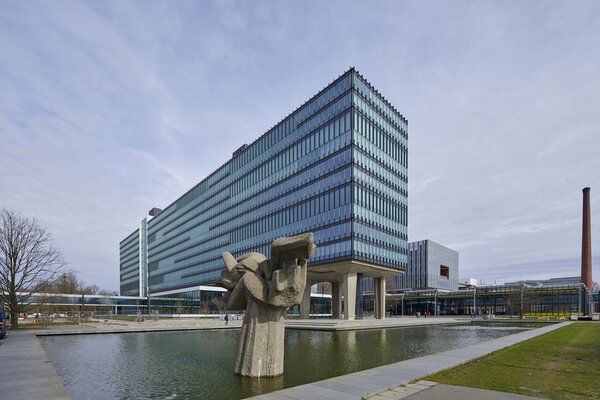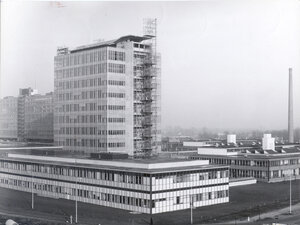BREEAM hails Atlas the world’s most sustainable education building
With a score of 96.01%, the Atlas building is at the very top of the BREEAM list of the most sustainable education buildings in the world. The Executive Board of TU/e received the corresponding certificate on 16 April, 2019, during the National BREEAM Congress. Atlas is the result of the renovation of the former TU/e Main building, which was completed this year. As a result of this renovation, the building’s CO2 emissions have been reduced by around 80 percent while the number of users has more than doubled. This reduction is partly due to the highly insulating glass facade and the fact that the building no longer uses fossil fuels: it’s connection to the gas grid is shut off.
Read more about the sustainability of Atlas.
OpZuid project Atlas
In the Netherlands there are some 12,000 educational buildings that were built before 1990. One by one they are in need of renovation. In these renovation processes, proven technologies are often chosen, as a result of which sustainability innovations are slow to be implemented in the market. The Atlas building contributes to accelerating the introduction of various sustainable innovations by using new-to-market innovations in the renovation process, such as the innovative climate façade, the intelligent lighting infrastructure and the smart district heating system. The application of these innovations leads to an 80% reduction in CO2 emissions.
Read more about the OpZuid project Atlas (in Dutch).
Subsidy
The European Union has given subsidy to make the Atlas building the most sustainable education building in the world. The building has to serve as an example in the field of sustainable renovation.
Atlas will be possible thanks to a contribution of these parties.
More about Atlas
Atlas forms the stepping stone between the Auditorium (lecture halls) and the MetaForum (student domain). The building consists of a high-rise, which mainly forms the habitat of employees and students, and a lower section with broader campus provisions. Apart from the corporate services of TU/e, the high-rise accommodates the departments of Industrial Design and Industrial Engineering and Innovation Sciences. It is an efficiently equipped building that provides room for a lot of interaction. In the low-rise of Atlas educational halls and study/flexible workplaces are located, as well as a number of staff restaurants and the University Club. In many respects Atlas is a special building, particularly so as regards its sustainability. It is the largest energy-saving project on the TU/e Campus.
Original building period (Hoofdgebouw): 1958 – 1963 (Design: ir. S.J. Van Embden)
Atlas, the former, sturdy Hoofdgebouw from the 1960s, designed by ir. S.J. van Embden, was a flexible building even then. At the time of its opening it was the largest building in the Netherlands with a contiguous, so-called glass curtain wall.
Renovation period: 2014 – 2019 (Design: Team V Architectuur)
The architectural quality of the original design was preserved during its renovation in 2014. The steel façade construction and the mezzanine floors have been reused and the spatial quality of the low-rise has been restored. As a result, Atlas has been transformed into a transparent and energy-efficient university building. The concrete table construction supporting the high-rise gives the building a monumental look. A conspicuous addition was given to the central hall under the high-rise, which Van Embden called the ‘cathedral’, in the form of a red stairway. This red stairway winds through the building like an adventurous route, all the way up to the top floor. All the general provisions, such as the lecture halls and the study areas, have been positioned around this stairway. Thus, the stairway is the connecting factor between the two departments that have been accommodated on either side of the stairway, each on one side of the building. Throughout the building one can find wall paintings of well-known book covers.
Check out the book about Atlas, with photo's from Norbert van Onna and text from Bernard Colenbrander and Joep Huiskamp.


